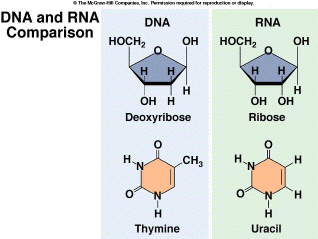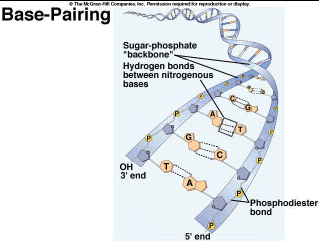Nucleic Acids
The final group of biologial macromolecules are the nucleic acids, which function to store genetic information and to express that information in the production of polypeptides. The monomer of nucleic acids is the nucleotide. This monomer consists of three parts (Figure 2.19). The first is a five-carbon sugar molecule, either ribose or deoxyribose. The nucleic acid DNA has deoxyribose as its sugar, and the nucleic acid RNA has ribose (Figure 2.20). This sugar is joined to a phosphate group. These phosphates and sugars alternate to form the backbone of the nucleic acid. The third component, the nitrogenous base, is also bonded to the sugar, and is approximately perpedicular to the sugar/phosphate backbone. There are four types of nucleotides in DNA and RNA. Both include the nucleotides adenine (A), cytosine (C) and guanine (G). DNA includes the nucleotide thymine (T), which is replaced by uracil (U) in RNA (Figure 2.20). 
Figure 2.19. The Structure of a Nucleotide
Figure 2.20. DNA and RNA Comparison |
||
RNA molecules are a single strand of nucleotides, whereas DNA is composed of two nucleotide strands that twist around each other. The structure of DNA is called a double helix (Figure 2.21). The two strands are held together by the hydrogren bonding of the nitrogenous bases. If you untwist the DNA and think of the sugar/phosphate backbone as the sides of the ladder, then the nitrogenous bases would be the rungs. The base adenine, which has a double ring structure, pairs with thymine, a single ring, while guanine, a double ring, pairs with cytosine, a single ring. This keeps the same spacing between the sides, thus insuring that the double helix has a constant width. We will discuss nucleic acids in much more detail in lesson 7.
|
|
Figure 2.21. Base-Pairing |
To continue to the next page, click on next at the top or bottom of the page (on the right side.)


